As in most years, I try to finish up my mason bee housing about now, so that the mason bees that wake up soon will be able to deposit their eggs before dying in my orchard. I mostly use teasel, an invasive weed around here that has hollow tubes, that are basically mostly the right size for mason bees (5/16 inch). I have also used himalayan honeysuckle. They are easy to cut into 6" lengths, which maximizes the likelihood that you will have equal numbers of males and females. Remember, Valentine's day is just around the corner!
Last year, I didn't finish one of my buckets of tubes. I left it on a table, and it filled up with mason bee eggs! A few years ago, I noticed some of the tubes being removed and left on the ground. I asked my kids, they didn't know. Squirrels remove them individually to try to eat the larva of the mason bees. Then I started tying them together with a bungee cord. I stuff more and more into the cord, and then the squirrels can't remove them individually. Then I drill tiny holes in each side of the bucket and tie the whole bundle into the bucket. Squirrels can't bother them anymore.
I also leave a can with mud just below the bucket, so the mamas can put their eggs to sleep with clay mud. Otherwise, they fly away elsewhere. They are called mason bees for a reason.
John S
PDX OR
Are the walls of the honeysuckle as sturdy as teasel? Can honeysuckle take the cords you wrap them with and not be crushed?
In regards to the nesting you place in buckets, have you seen return activity inside the bucket, and what color is the bucket? Last year I had success attracting mason bees to new places by inserting hollow teasel into a brown background of wood but unsuccessful when the background was white vinyl.
Added comments below 5 days later on Saturday evening:
I think I need to answer my own questions so here we go...

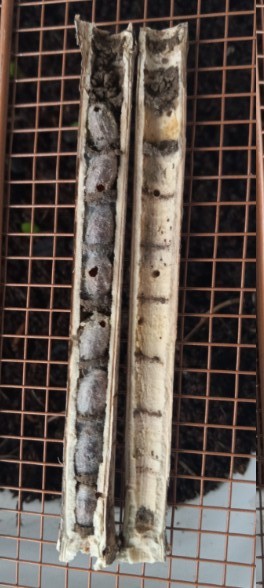 Right --> expanded
Right --> expanded
The left image is teasel placed with white background. This is illustrative of what not to do because bees were never attracted to or seeing this with too much white as very attractive. For reasons I'm not quite sure bees had visited cherry flowers right next to the window for enough days to have seen this. All the attention of filling my teasel placed in a natural brown (not white) had lots of attention and filled in 3 days while cherry bloomed. Bees might be seeing the holes but also see thier own shadow or reflection on clear white as an intruder.
The right side is teasel I removed from the home built natural homes. The teasel was softened enough to take an almost razor kind knife and make the lengthwise split. I folded it open and seen what appears to be parasites (ie. holes on both sides) that have not been accounted for in the plan. Very few bees at best are still alive.
Live and learn. I must have left too much spacing between teasel reeds in my original style of housing where which parasitic wasps events must have happened.
If teasel is rigid enough to support pressure of bundling (ie. John S) then maybe now I know why. If teasel is this easy to split in this cool high humid time of year and even where they were under eves then I suppose they must be bundled to exclude parasitic wasps. It is still however not sufficiently clear what you have done John, without seeing it first?
Once again, you bring up great points, Rooney.
Yes, the Himalayan Honeysuckle is very sturdy. It's much sturdier than the teasel. I have heard other people using other hollow tubes-Japanese knotweed, maybe?
The bees have revisited many of the buckets. Some I used were red, old coffee containers. They were filled up quickly. I was worried that black ones would get too hot and burn the cocoons. There were some white ones that weren't revisited very much. You bring up a good point. I could try to find some brown paint or something. I know I have seen others bundle their tubes. I did it to stop squirrels stealing the larva, but others may do it to stop the parasitic wasps. I don't know.
Dave of Crown Bees mentions that natural bee tubes fill up way faster than manufactured, exactly equal ones, and that having mud nearby is crucial.
I may try to get out there and take some photos but I don't have them right now.
John S
PDX OR
Rooney, looks like your tubes were hit by mono wasps. Mono wasps become active just as mason bees are winding down. I bring all my tubes into our treehouse around June 1, which protects them from the vast majority of mono wasps. But there are always a few early bird wasps. Here's a video of the mono wasps trying to get into the treehouse (in early July): https://photos.app.goo.gl/4hfZ.....p9GsBVLMY6
Re: opening teasel. Notice how there is only mud (no cocoons) at the open end of the tube. You can safely use a pair of pruning shears to make a linear cut in that end of the tube, then give the shears a bit of a twist, and the tube will begin to split. If you're lucky it will split all the way to the end. If not, you will have to use your fingers, or make a very tiny cut in the other end (note the cocoons are much closer at that end). Here's a video I made: https://photos.app.goo.gl/oZ5J.....s6VFbZdUS6 Note how I often hold the end of the stem against my leg. I usually do this step together with other people, and we sit around wading pools to catch the cocoons: https://photos.app.goo.gl/21AF.....3sz5utNt7A
Re: bee preferences, I have done some experiments and in my yard their favorite materials are:
- Bamboo
- Teasel
- Ground plug in outdoor power outlet/extension cord 🙂
- Overlapping sheets of T1-11 siding (in the crevices)
- Cedar shake siding/roofing (crevices between the shakes)
- Cardboard or paper tubes
- Wood trays
I have found bamboo to be a pain to work with. You have to cut it with a saw, and you have open it with a chisel, both of which are somewhat dangerous. Wood trays work well if the bees have no other choice. So if you use those, don't put out anything else.
I have teasel in my yard/neighborhood so that is what I always use. I would love to switch to some native plant though. I have heard that milkweed works.
Wood blocks/logs with holes drilled are popular the first year but not subsequent years, due to the buildup of parasites/fungi. Unless you put paper liners in them each year.
In nature, the bees use holes in old trees made by sapsuckers, woodpeckers, insects etc., and in dead hollow-stem plants. I bet they also nest under bark that is peeling from dying/dead trees. In other words, in places that look messy and dangerous to us.
Re: mud, I have tried putting out all kinds of clay/mud of varying consistency for the bees, right next to the nesting bundles, and they have never used it. I think they can find what they need from the ground and that is where their instinct tells them to go. If I dig a hole for them, they do almost always use those. They are very finicky about the mud/clay and will crawl all around the hole to find mud that is just right. Once they find that spot, they will tunnel into the side of the hole to get more of that mud. Over time these tunnels can get quite large, here's a video: https://photos.app.goo.gl/3Auv.....T6g9E6GA I usually make the hole by putting a spade all the way into the ground and rock it back and forth to make a slot in the ground about 6" wide at the top.
I was not familiar with the term "Mono wasp".
Mono is short for Monodontomerus.
For Mason Bees, there may be two parallel pests in our region:
https://blogs.oregonstate.edu/.....udini-fly/
^Ms. Natter has been a regular contributor to the Oregonian Home and Garden Q&A section for years.
^the wasps are mentioned below the 2nd image in the article.
^scroll to end to read local comments.
The last link in my post seems to be broken (mason bee mud tunnel) - try this: https://photos.app.goo.gl/bQYv.....paFciDz2N9
Larry_G said
For Mason Bees, there may be two parallel pests in our region:
Other pests/diseases/predators which I have seen:
- pollen mites. Eats the pollen before the mason bee larva can.
- chalkbrood fungus. I have mainly seen this with tubes that have been exposed to rain for some period of time.
- squirrels. I think they are after the pollen and/or larvae.
There are also other creatures which like to use the tubes. They don't seem to harm the bees, but they do use up tubes. Bees won't use a tube that has something else in it.
- ants
- earwigs
- various beetle species
- spiders
When I bring the tubes in the treehouse, it turns into a whole ecosystem in there - spiders emerge and catch everything else that emerges (or which happened to be in the bundle of tubes).
I put cans of extreme clay soil under the tubes, on the soil. They have a small hole in them to drain when it's too rainy. It has greatly increased the number of "masoned" bee larva in the tubes. I check them each year to make sure they don't have extra leaves, moss, plants, etc. Pretty easy, I just rub the clay on top until it's just clay again. In very dry spells in the spring, I will add water to the cans.
John S
PDX OR
I was cleaning my wooden mason bee trays today and found very hard filling in some slots. As I chipped the slots clean I could smell pine resin. My bee shelter is near ponderosa pine trees. I wonder if a bee collected pine pollen and filled these slots and then it solidified.
I found some leafcutter bees in the trays. I also have sweat bees later in the summer but they seem to like 3/16” holes better than the 5/16” slots. I drill small wooden blocks for them.
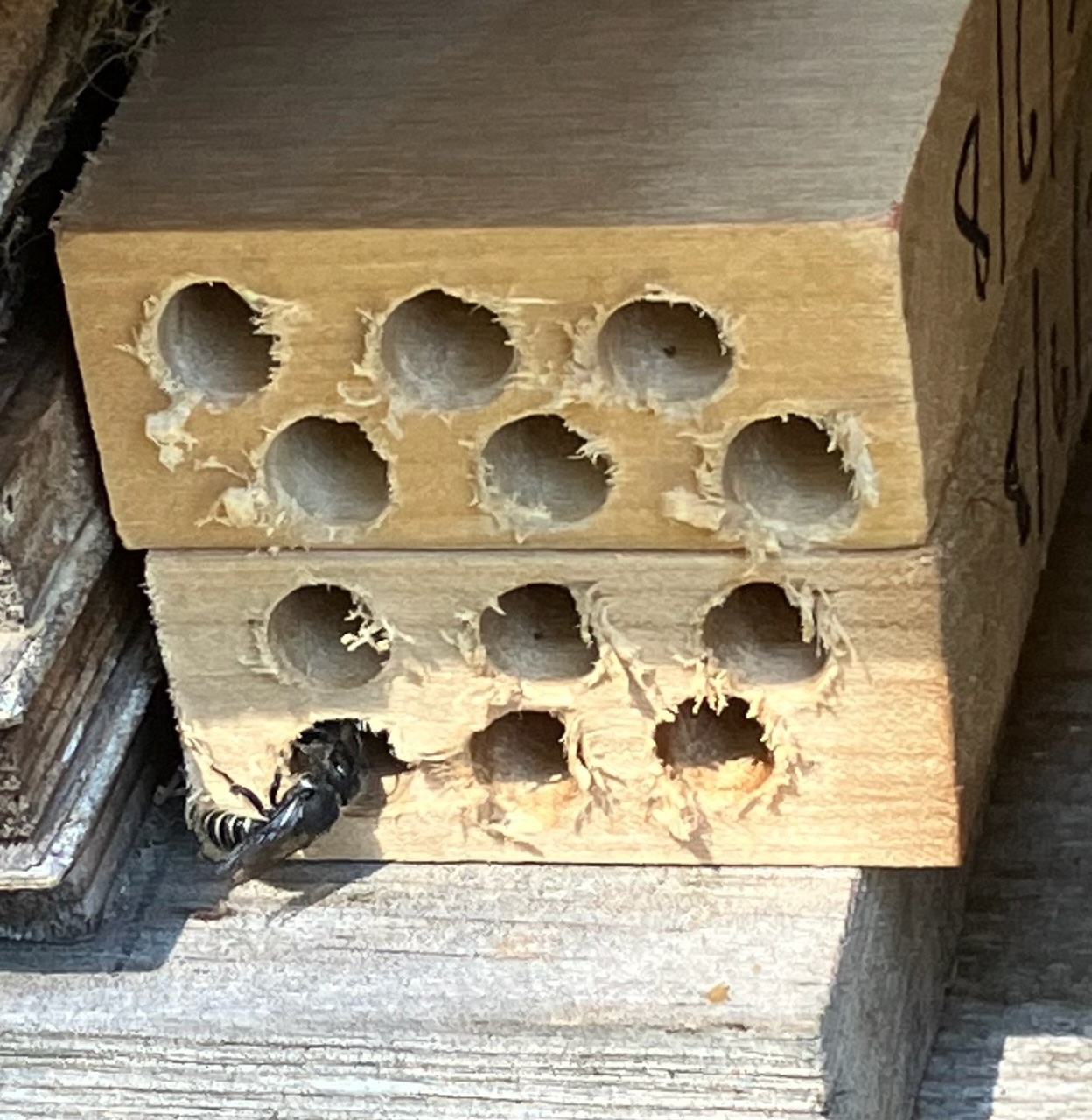
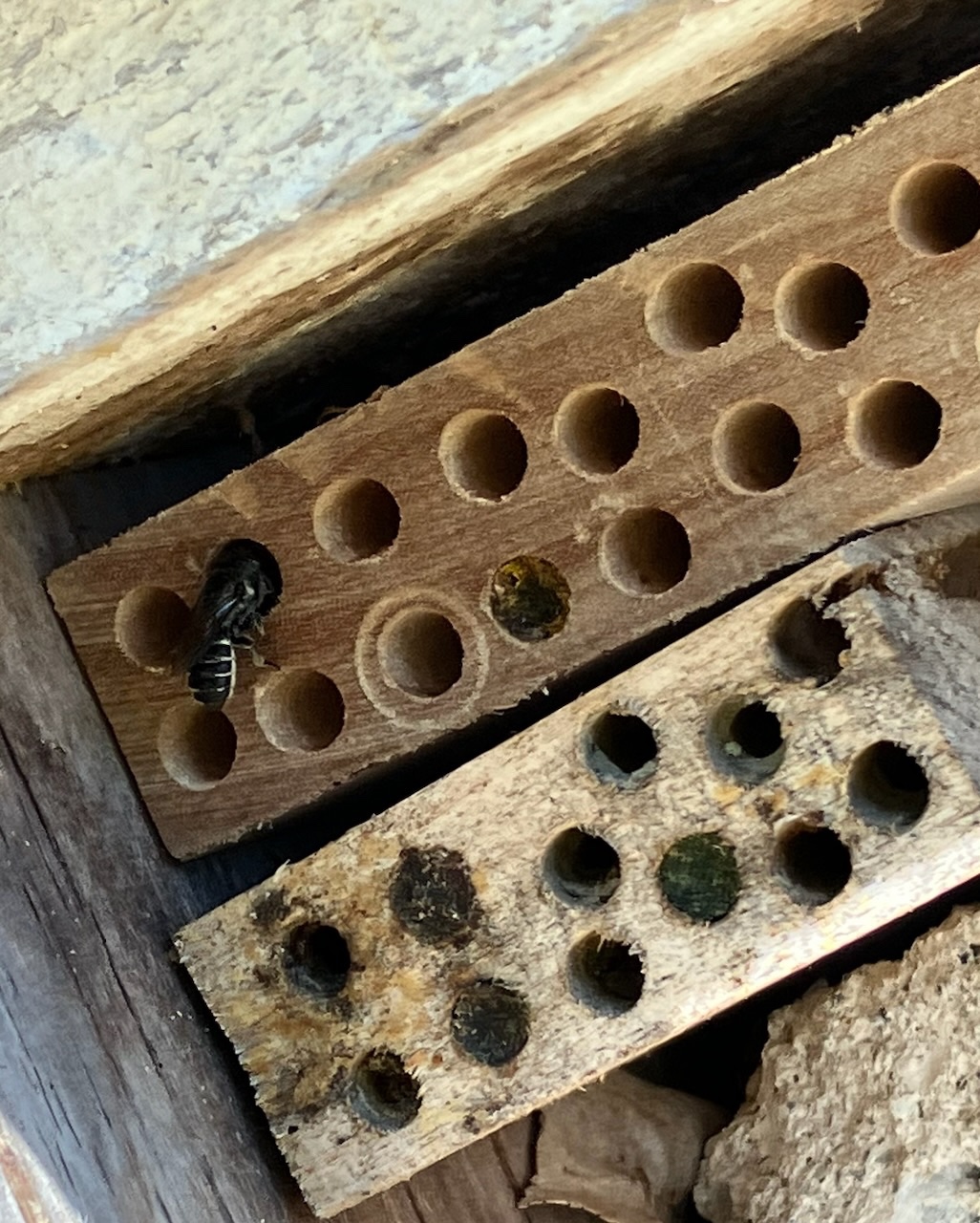
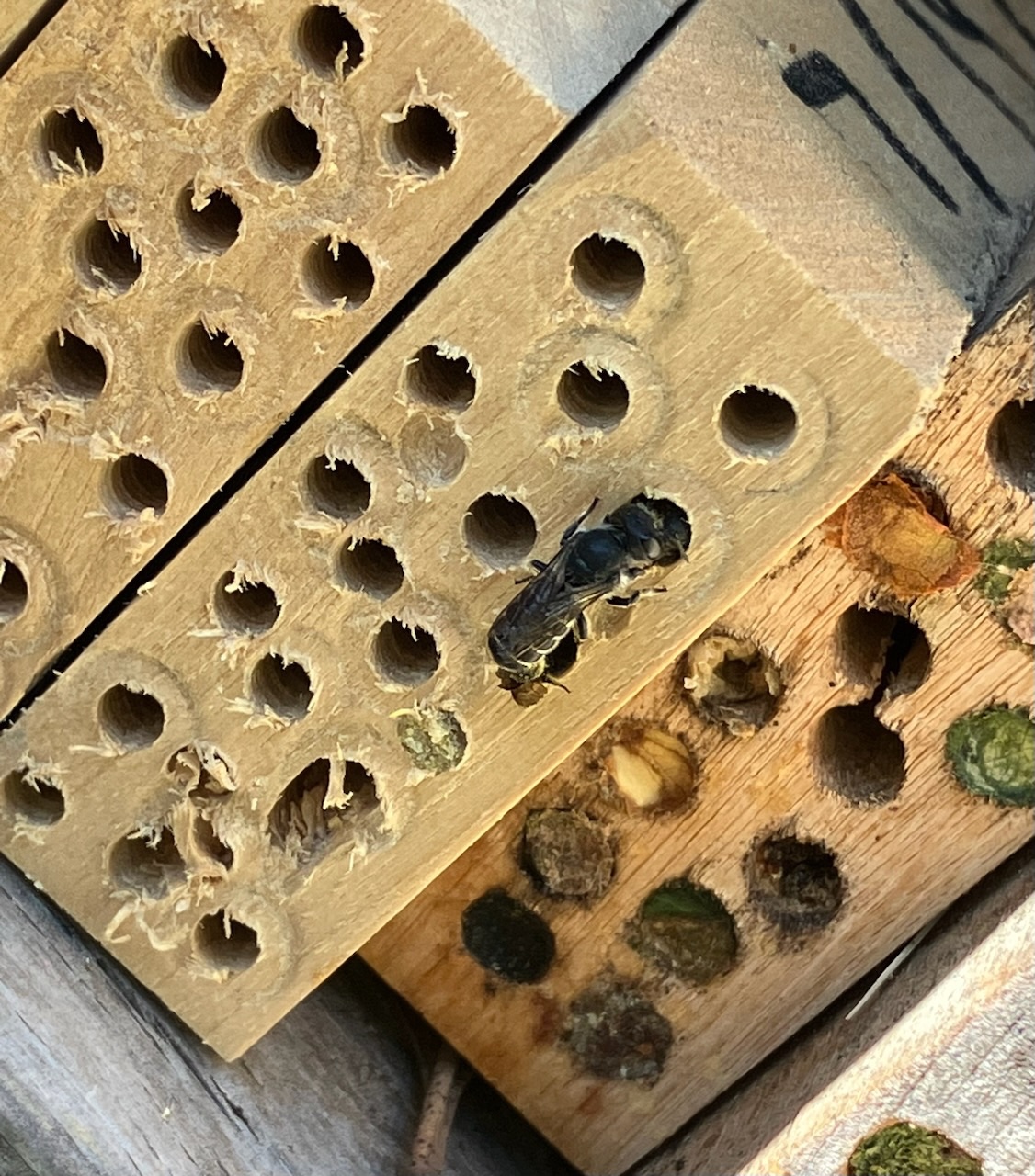
This is my answer to what Dave had suggested was mono-wasp damage to my teasel.
 --> expanded as here
--> expanded as here
This is sand that I took from the public beach access from the river. Time will tell how effective this sand fill is going to be in excluding the female mono-wasps from my newly created reeds. (fingers crossed)
Per dubyadee as for the possibility of bees collecting from pines: I found the same thing when splitting teasel in which one I found yellow untouched pollen. I didn't bother to check what it smelled like so I can't say for sure these mothers are so ignorant of knowing any better. In desperation it may be possible when nothing is flowering at the times pines shed pollen. I also think it's possible that her eggs are triploid or alloploid like individuals as the result of male mating with double sets of chromosomes. She could be an alloploid herself. If either of these two case were true the eggs from her, or possibly yours, as smart as mothers may be, would be in vain.
I've just noticed the past couple of days that more squirrels are removing the mason bee tubes made out of teasel. I opened it to investigate and then I found out why. This was one of my earlier ones, in which I hadn't held them together tightly with the bungee. The squirrels were able to pull them out of the container. I bound them up with the bungee, retied the bundle through the container, and reput them up in the eave.
Interestingly, I was initially worried that the coffee container was just made of cardboard and wouldn't endure. Since it is below the eave, it hasn't suffered any damage.
When I saw that the squirrels were removing them, I initially thought to put them in the house so the squirrels wouldn't continue to extract them. Then I realized that in March, many of them are waking up. Putting it i a warm house, even for the night,might wake them up quickly and have them hunting in the house for pollen. I left them in the unheated tool shed overnight.
JohnS
PDX OR
Thanks for all of the competitive ideas for building homes from everybody. I had not noticed until today how many podcast sessions Dave actually linked. I took special interest in the finding of more unhatched eggs during the normal maintenance. I imaged the latter stages of Dave's nice show.
Isn't it the thumb that shows the exit point opening?
Isn't it the first nearest the exit that male bees are reared?
Is it likely the furthest stacked backwards to the left that never hatched were intended to be females?
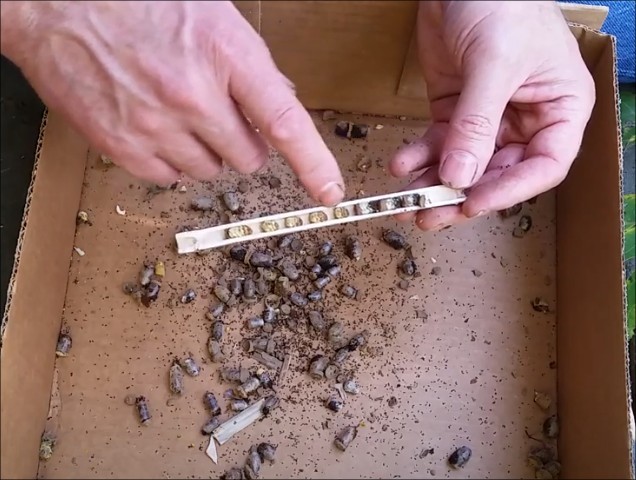 --> zoom
--> zoom
I think these questions may be given an almost all-in-one answer by considering the header at the top of what this following link leads to;
assigning which special eggs go where for honey bees
So Dave. Another good idea might be to find a couple of hungry praying mantis to wipe out that interesting population of mono-wasps as far as your other cast is concerned of being drawn towards that tent screen. If the links were designated in a different style of color these may stand out a little more.
Hi,
New to forum.
My end of mason bee season 2023.
I have made some nesting blocks that are are nearly filled this season, as compared to a poor 2022 season.
Here is a photo of one of my nesting blocks(I hope google photos links work).
https://photos.app.goo.gl/NQxG.....cAmPPyX3d9
Paper straw within a permanent paper straw, close packed in 3D printed, napkin ring-like, seems to restrict most all predators(excepting the Houdini fly)
I tried 5 minute per day vacuuming houdini flies to significantly reduce their numbers.
As of June 2 I still have a few bees working but will bring in the blocks to my garage by mid June, to protect from birds or squirrels.
Here's one of my totes of stems on May 17. In total I deployed about 9200 empty stems, along with hundreds of filled ones from last year. I did open some last year, but I have way too many to open by myself. I used to have a volunteer group that helped me (we sold the extras as a fundraiser), but that group disbanded. I estimate that I'll have about 6500 filled stems this year.
Squirrels got about 5 bundles a few weeks ago. So all but 3 bundles are now in the treehouse, plus some that I have at other sites. A few ladies are working on the 3 bundles still, but I expect them to finish up in the next few days, and the mono wasps will show up shortly.
Needless to say, the mason bees really like my yard.
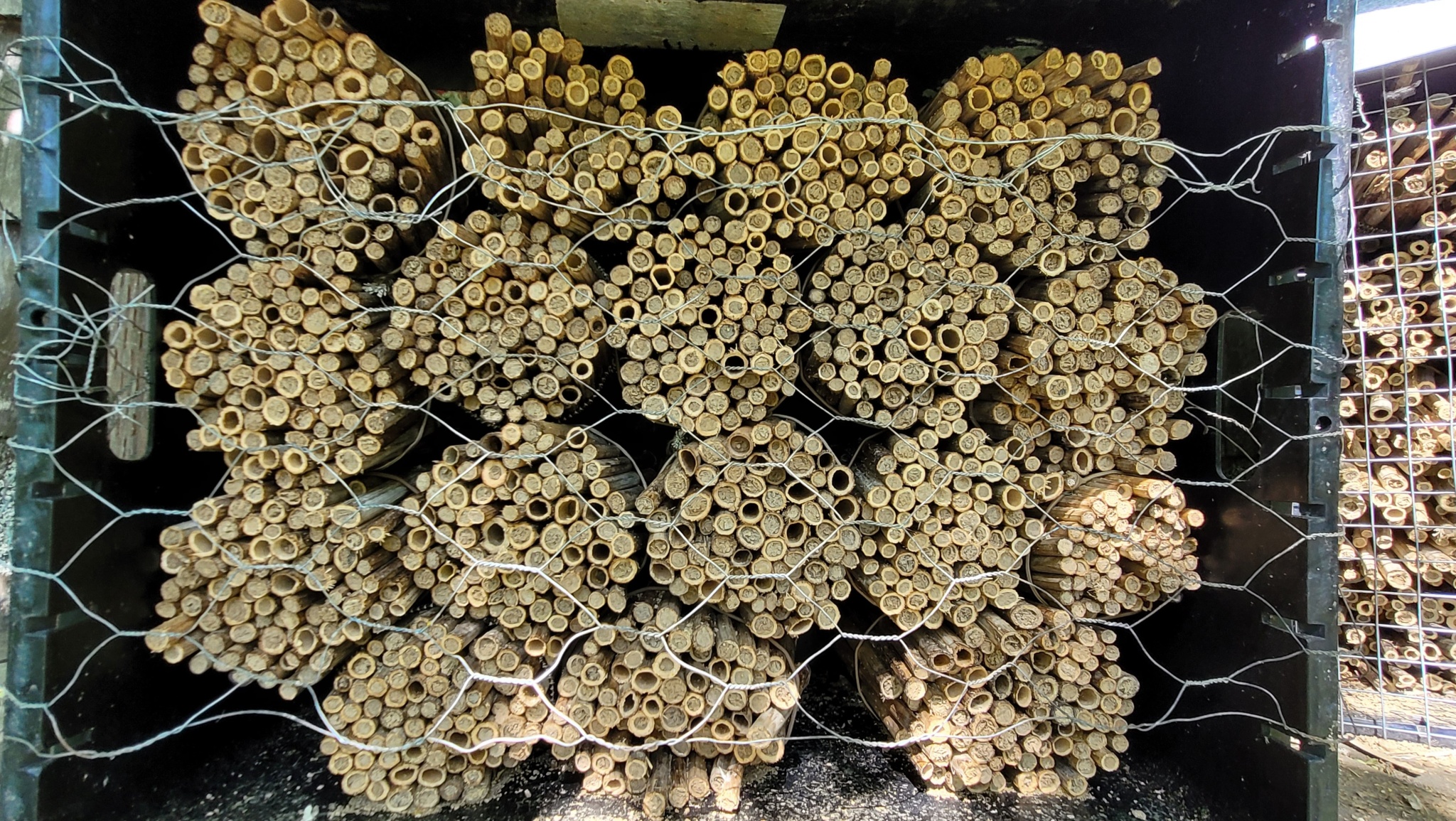
@GeodesicSteve I really like the look of your setup. It's evident that you've put a lot of thought and effort into it. Do you hand roll the inner, disposable paper tube?
The varied mud colors give an artistic effect. I don't think I've seen that before. Do you know why you've got that range of colors?
btw, welcome to the forum. Did you have any difficulty in setting up your account and gaining access?
I cut printer paper in six pieces, 5-1/2 by approx 2-3/4" and roll them on a round pencil,or any rod that is approx 5/16 diameter.
By hand is very quick and easy just having the module sitting on the table where I am rolling them.
The multi-color is because each female has a limited quantity of eggs, less than 30 I believe.
So each straw only has room for maybe 6 cocoons, then one female would only use 5 straws max.
And I probably have multiple sources and textures of mud around my garden, that is why I get the nice texture art.
I did not have any difficulty setting up my account.
Here is a link to more production photos: https://photos.app.goo.gl/VvFu.....dnbjTp18B7
We are trying to get our house painted but have to first replace a bunch of siding because the genius previous owners fastened things directly to the siding with no flashing.
Here was a vertical 2x4 supporting some of a covered patio roof support.
BTW, image literally just copied and pasted into the message body using Chrome on Windows PC. Seems more painless than in the past.
jafar said
We are trying to get our house painted but have to first replace a bunch of siding because the genius previous owners fastened things directly to the siding with no flashing.Here was a vertical 2x4 supporting some of a covered patio roof support.
BTW, image literally just copied and pasted into the message body using Chrome on Windows PC. Seems more painless than in the past.
They will also do this if you have T-1-11 on a gable end where the sheets overlap. That is part of my theory why my most successful mason bee houses (besides my yard) are in the Fairway Village neighborhood - most of the houses there have T-1-11 sheets that overlap.
Also notice how many cells there are. Online the "experts" all say that your tubes should not be more than 6" long. I put out longer ones sometimes, and often when I open them they look just like your picture, i.e. 20-30 cells.
Idyllwild
jafar
Marsha H
Viron
John S
1 Guest(s)
